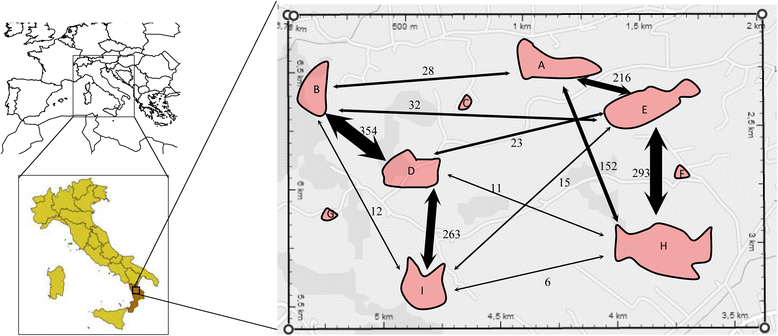Effects of population structure on pollen flow, clonality rates and reproductive success in fragmented Serapias lingua populations
- PMID: 26377667
- PMCID: PMC4573484
- DOI: 10.1186/s12870-015-0600-8
Effects of population structure on pollen flow, clonality rates and reproductive success in fragmented Serapias lingua populations
Abstract
Background: Fragmentation of habitats by roads, railroads, fields, buildings and other human activities can affect population size, pollination success, sexual and asexual reproduction specially in plants showing pollinator limitation, such as Mediterranean orchids. In this study, we assessed pollen flow, selfing rates, vegetative reproduction and female reproductive success and their correlations with habitat characters in nine fragmented subpopulations of Serapias lingua. To improve understanding of population structure effects on plant biology, we examined genetic differentiation among populations, pollen flow, selfing rates and clonal reproduction using nuclear microsatellite markers.
Results: Smaller populations showed a significant heterozygote deficit occurred at all five nuclear microsatellite loci, the coefficient of genetic differentiation among populations was 0.053 and pairwise FST was significantly correlated with the geographical distance between populations. Paternity analysis of seeds showed that most pollen flow occurred within a population and there was a positive correlation between percentage of received pollen and distance between populations. The fruit production rate varied between 5.10 % and 20.30 % and increased with increasing population size, while the percentage of viable seeds (78-85 %) did not differ significantly among populations. The extent of clonality together with the clonal and sexual reproductive strategies varied greatly among the nine populations and correlated with the habitats where they occur. The small, isolated populations tended to have high clonal diversity and low fruit production, whereas the large populations with little disturbance were prone to have reductions in clonal growth and increased sexual reproduction.
Conclusions: We found that clonality offers an advantage in small and isolated populations of S. lingua, where clones may have a greater ability to persist than sexually reproducing individuals.
Figures


Similar articles
-
Ecological perspectives on female and male reproductive success with competition in two Serapias species.Ann Bot. 2024 Jul 9;134(2):311-324. doi: 10.1093/aob/mcae074. Ann Bot. 2024. PMID: 38712800 Free PMC article.
-
Pollination by sexual deception promotes outcrossing and mate diversity in self-compatible clonal orchids.J Evol Biol. 2015 Aug;28(8):1526-41. doi: 10.1111/jeb.12673. Epub 2015 Jul 3. J Evol Biol. 2015. PMID: 26079670
-
Pollen limitation and the contribution of autonomous selfing to fruit and seed set in a rewarding orchid.Am J Bot. 2015 Jan;102(1):67-72. doi: 10.3732/ajb.1400449. Epub 2014 Dec 22. Am J Bot. 2015. PMID: 25587149
-
On the success of a swindle: pollination by deception in orchids.Naturwissenschaften. 2005 Jun;92(6):255-64. doi: 10.1007/s00114-005-0636-y. Naturwissenschaften. 2005. PMID: 15931514 Review.
-
Mechanisms and evolution of deceptive pollination in orchids.Biol Rev Camb Philos Soc. 2006 May;81(2):219-35. doi: 10.1017/S1464793105006986. Biol Rev Camb Philos Soc. 2006. PMID: 16677433 Review.
Cited by
-
Ecological perspectives on female and male reproductive success with competition in two Serapias species.Ann Bot. 2024 Jul 9;134(2):311-324. doi: 10.1093/aob/mcae074. Ann Bot. 2024. PMID: 38712800 Free PMC article.
-
Transcriptome data reveals the conservation genetics of Cypripedium forrestii, a plant species with extremely small populations endemic to Yunnan, China.Front Plant Sci. 2024 Jan 31;15:1303625. doi: 10.3389/fpls.2024.1303625. eCollection 2024. Front Plant Sci. 2024. PMID: 38357270 Free PMC article.
-
Functional differentiation in pollination processes among floral traits in Serapias species (Orchidaceae).Ecol Evol. 2017 Aug 2;7(18):7171-7177. doi: 10.1002/ece3.3264. eCollection 2017 Sep. Ecol Evol. 2017. PMID: 28944008 Free PMC article.
-
Pollination mechanism in Serapias with no pollinaria reconfiguration.AoB Plants. 2023 Aug 16;15(5):plad054. doi: 10.1093/aobpla/plad054. eCollection 2023 Oct. AoB Plants. 2023. PMID: 37899971 Free PMC article.
-
Unravelling some factors affecting sexual reproduction in rock-specialist shrub: Insight from an endemic Daphne arbuscula (Thymelaeaceae).PLoS One. 2024 May 9;19(5):e0300819. doi: 10.1371/journal.pone.0300819. eCollection 2024. PLoS One. 2024. PMID: 38722920 Free PMC article.
References
-
- Newman BJ, Ladd P, Brundrett M, Dixon KW. Effects of habitat fragmentation on plant reproductive success and population viability at the landscape and habitat scale. Biol Conserv. 2013;159:16–23. doi: 10.1016/j.biocon.2012.10.009. - DOI
-
- Pellegrino G, Bellusci F. The effects of human disturbance on the demography and reproductive success of Serapias cordigera (Orchidaceae) Bot J Linn Soc. 2014;176:408–420. doi: 10.1111/boj.12204. - DOI
-
- Aguirre A, Dirzo R. Effects of fragmentation on pollinator abundance and fruit set of an abundant understory palm in a Mexican tropical forest. Biol Conserv. 2008;141:375–384. doi: 10.1016/j.biocon.2007.09.014. - DOI
-
- Öckinger E, Dannestam Å, Smith HG. The importance of fragmentation and habitat quality of urban grasslands for butterfly diversity. Landsc Urban Plan. 2009;93:31–37. doi: 10.1016/j.landurbplan.2009.05.021. - DOI
Publication types
MeSH terms
LinkOut - more resources
Full Text Sources
Other Literature Sources
Miscellaneous

